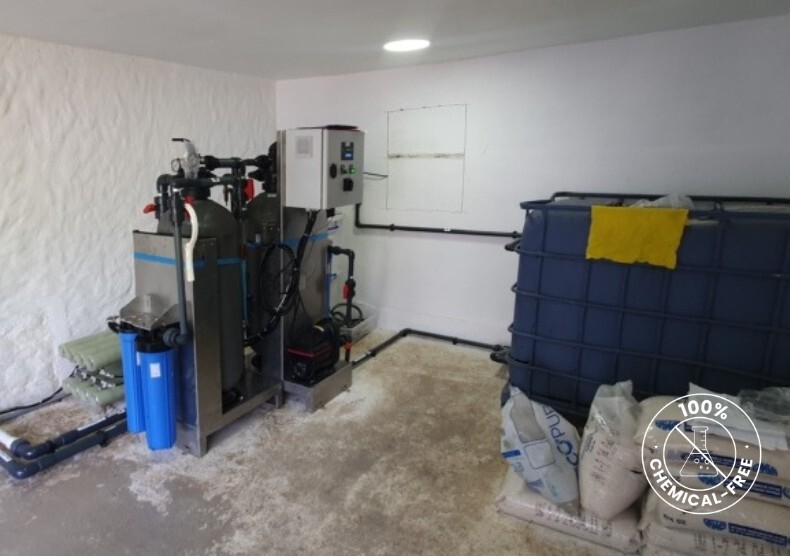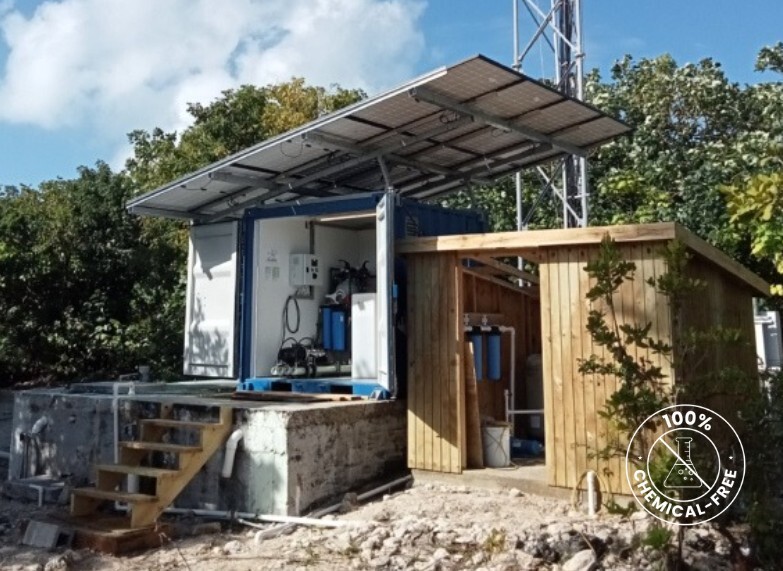Reliable. Sustainable. Climate-resistant. These are some reasons why seawater desalination is gaining traction. If you’re thinking of making the switch, you’ll want to know how safe the water is. While freshwater produced through desalination has proven to be clean and safe, the use of harsh chemicals to clean traditional systems has raised concerns for both consumers and the environment. For this reason, many are now searching for chemical-free desalination systems and eco-friendly water treatment technologies that align with modern water purification and customer safety standards.
Why do water desalination plants use chemicals? Is there a better solution? Let’s talk about it.
The Future of Freshwater
Desalination is the process of removing salt and other impurities from seawater or brackish water to produce clean, drinkable water. In essence, it makes seawater fit for human consumption. Solar desalination takes this further. It uses renewable energy and supports long-term water security in regions with limited freshwater.
There are different types of desalination systems, but the most common are reverse osmosis (RO) and thermal desalination. Among the two, reverse osmosis is preferred for its superior energy efficiency, making it an ideal choice for sustainable infrastructure and low-impact water treatment in coastal regions and remote communities.
 Why Do Water Desalination Systems Rely on Chemicals?
Why Do Water Desalination Systems Rely on Chemicals?
Traditionally, water desalination was done on a large scale. It required substantial infrastructure and heavy maintenance and was run or owned by local governments or utilities to supply water to local communities, urban households, industries, or the military.
To meet such demand, these plants need to function smoothly and efficiently at all times. Here’s where the use of chemicals comes in. Large-scale desalination plants rely on chemical agents at various stages to maintain system performance, minimize fouling, and prevent scaling and corrosion – especially due to the high salt and mineral content in seawater. This is particularly common in water utilities and businesses that rely on uninterrupted supply and regulated water quality.
Typically, chemicals are used at different stages like,
- Before treatment: The nanofiltration membranes in RO systems tend to get clogged with impurities and accumulate residue over time. It can also cause microbial growth. So, chemicals like anti-scalants, biocides, and flocculants are commonly used to treat these issues.
- After treatment: Chemicals like chlorine and re-mineralization additives are added after desalination as water treatment measures to adjust the quality and safety of distributed water.
- Periodical maintenance: More cleaning agents are needed from time to time to restore membrane performance after it has been subjected to fouling. This is because even with pre-treatment, plants can still accumulate mineral deposits and biofilms.

No Chemicals
Only manufacturer in the industry
100% Solar
Hybrid system, can be fully powered by solar energy
Health Risks: The Hidden Cost of Desalination
While the many chemicals added during desalination are meant for your safety, did you know they can compromise your well-being?
The chemicals or cleaning agents added for treatment are supposed to neutralize but it’s not always the case. There can be traces of these chemicals in the water you drink and prolonged exposure can lead to various health issues.
For example, adding chlorine to desalinated water for purification can actually be harmful if it reacts with the organic matter in water. Disinfection byproducts (DBPs) formed by this reaction have been linked to cancer, reproductive issues, and organ toxicity, especially with prolonged exposure.
Bluemont’s EWM Solar Desalination Systems are 100% chemical-free!
Impact on the Environment
Water desalination systems that use chemicals can also have a negative impact on the environment because of the brine waste.
Brine is a byproduct of water desalination and contains salt and mineral particles. It is usually released back into the oceans. If there are any traces or residue of chemicals in the brine, it can disrupt the marine ecosystems and destroy marine life. Besides polluting our oceans, brine with high chemical content can also affect the salinity in marine environments. Our marine ecosystems are already fragile and affected by climate change. It can worsen the issue. This is why eco-friendly desalination systems with sustainable water purification technologies are critical!
 Chemical-free Desalination with EWM Solar Desalination System
Chemical-free Desalination with EWM Solar Desalination System
EWM Solar desalination systems by Bluemont overcome all these issues! You no longer have to worry about the potential health hazards of consuming desalinated water or about polluting the environment!
As a chemical-free desalination solution, our systems ensure that the drinking water produced from our units is completely safe for consumption. Like other desalination water treatment systems, our units also use RO technology. The difference is that we don’t use harsh chemicals to clean our systems but still produce clean freshwater!
Instead of relying on cleaning agents, EWM units are engineered with a patented technique that uses a portion of the clean water produced during desalination to keep the system clean and running at its optimal level! This means, only the natural brine is released into the oceans. We ensure no harmful chemicals end up in our oceans while maintaining the water quality at the highest level.
EWM desalination systems can run entirely on solar or wind energy and are also a sustainable water purification method for urban and off-grid properties. Ideal for both residential and industrial water supply needs, EWS solar desalination systems have helped remote communities in coastal regions access freshwater easily.
Want to know more about chemical-free desalination? Send us your query or get in touch with us by calling +61 2 9091 0360. Bluemont is the leading supplier of EWM solar desalination units in Australia, New Zealand, and the Pacific Islands.
